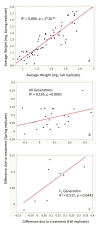Genetic and Sex-Specific Transgenerational Effects of a High Fat Diet in Drosophila melanogaster
- PMID: 27518304
- PMCID: PMC4982694
- DOI: 10.1371/journal.pone.0160857
Genetic and Sex-Specific Transgenerational Effects of a High Fat Diet in Drosophila melanogaster
Abstract
An organism's phenotype is the product of its environment and genotype, but an ancestor's environment can also be a contributing factor. The recent increase in caloric intake and decrease in physical activity of developed nations' populations is contributing to deteriorating health and making the study of the longer term impacts of a changing lifestyle a priority. The dietary habits of ancestors have been shown to affect phenotype in several organisms, including humans, mice, and the fruit fly. Whether the ancestral dietary effect is purely environmental or if there is a genetic interaction with the environment passed down for multiple generations, has not been determined previously. Here we used the fruit fly, Drosophila melanogaster, to investigate the genetic, sex-specific, and environmental effects of a high fat diet for three generations' on pupal body weights across ten genotypes. We also tested for genotype-specific transgenerational effects on metabolic pools and egg size across three genotypes. We showed that there were substantial differences in transgenerational responses to ancestral diet between genotypes and sexes through both first and second descendant generations. Additionally, there were differences in phenotypes between maternally and paternally inherited dietary effects. We also found a treated organism's reaction to a high fat diet was not a consistent predictor of its untreated descendants' phenotype. The implication of these results is that, given our interest in understanding and preventing metabolic diseases like obesity, we need to consider the contribution of ancestral environmental experiences. However, we need to be cautious when drawing population-level generalization from small studies because transgenerational effects are likely to exhibit substantial sex and genotype specificity.
Conflict of interest statement
Figures







Similar articles
-
Ancestral and offspring nutrition interact to affect life-history traits in Drosophila melanogaster.Proc Biol Sci. 2019 Feb 27;286(1897):20182778. doi: 10.1098/rspb.2018.2778. Proc Biol Sci. 2019. PMID: 30963851 Free PMC article.
-
Ancestral diet transgenerationally influences offspring in a parent-of-origin and sex-specific manner.Philos Trans R Soc Lond B Biol Sci. 2019 Mar 18;374(1768):20180181. doi: 10.1098/rstb.2018.0181. Philos Trans R Soc Lond B Biol Sci. 2019. PMID: 30966955 Free PMC article.
-
High amylose starch consumption induces obesity in Drosophila melanogaster and metformin partially prevents accumulation of storage lipids and shortens lifespan of the insects.Comp Biochem Physiol A Mol Integr Physiol. 2018 Jan;215:55-62. doi: 10.1016/j.cbpa.2017.10.011. Epub 2017 Oct 18. Comp Biochem Physiol A Mol Integr Physiol. 2018. PMID: 29054808
-
Quantitative genetic analyses of complex behaviours in Drosophila.Nat Rev Genet. 2004 Nov;5(11):838-49. doi: 10.1038/nrg1472. Nat Rev Genet. 2004. PMID: 15520793 Review.
-
Drosophila melanogaster as an alternative model organism in nutrigenomics.Genes Nutr. 2019 May 6;14:14. doi: 10.1186/s12263-019-0641-y. eCollection 2019. Genes Nutr. 2019. PMID: 31080523 Free PMC article. Review.
Cited by
-
Measurement of solid food intake in Drosophila via consumption-excretion of a dye tracer.Sci Rep. 2018 Aug 1;8(1):11536. doi: 10.1038/s41598-018-29813-9. Sci Rep. 2018. PMID: 30068981 Free PMC article.
-
Influence of Lab Adapted Natural Diet and Microbiota on Life History and Metabolic Phenotype of Drosophila melanogaster.Microorganisms. 2020 Dec 11;8(12):1972. doi: 10.3390/microorganisms8121972. Microorganisms. 2020. PMID: 33322411 Free PMC article.
-
Ancestral and offspring nutrition interact to affect life-history traits in Drosophila melanogaster.Proc Biol Sci. 2019 Feb 27;286(1897):20182778. doi: 10.1098/rspb.2018.2778. Proc Biol Sci. 2019. PMID: 30963851 Free PMC article.
-
Reference genes to study the sex-biased expression of genes regulating Drosophila metabolism.Sci Rep. 2024 Apr 25;14(1):9518. doi: 10.1038/s41598-024-58863-5. Sci Rep. 2024. PMID: 38664539 Free PMC article.
-
Parental obesity leads to metabolic changes in the F2 generation in Drosophila.Mol Metab. 2017 Apr 26;6(7):631-639. doi: 10.1016/j.molmet.2017.03.012. eCollection 2017 Jul. Mol Metab. 2017. PMID: 28702320 Free PMC article.
References
MeSH terms
Grants and funding
LinkOut - more resources
Full Text Sources
Other Literature Sources
Molecular Biology Databases

